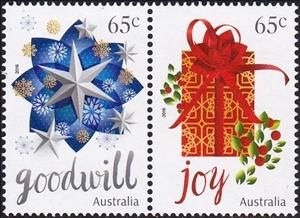Se-tenant: Goodwill and Joy (Australia 2016)
Goodwill and Joy (Australia 2016)
31 October (Australia ) within release Christmas 2016 goes into circulation Se-tenant Goodwill and Joy face value 2*65 Australian cent
| Se-tenant Goodwill and Joy in catalogues | |
|---|---|
| Michel: | Mi: AU 4585-4586 |
| Stamp Number: | Sn: AU 4567a |
Se-tenant is horizontal format.
Also in the issue Christmas 2016:
- Stamp - Goodwill face value 65;
- Stamp - Goodwill face value 65;
- Stamp - Goodwill (Foiled) face value 65;
- Mini Sheet - Goodwill Embellished Sheetlet face value 6.50;
- Stamp - Joy face value 65;
- Stamp - Joy face value 65;
- Stamp - Joy (Foiled) face value 65;
- Mini Sheet - Joy Embellished Sheetlet face value 6.50;
- Stamp - Mary tenderly cradling Jesus face value 65;
- Stamp - Angel face value 1.70;
- Stamp - Three Wise Men face value 2.55;
- Stamp - Angel face value 1.70;
- Stamp - Mary and Child face value 65;
- Stamp - Three Wise Men face value 2.55;
- Booklet - Goodwill and Joy face value 20*65;
- Booklet - Mary and Child face value 20*65;
- Booklet - Angel face value 5*1.70;
- Booklet - Three Wise Men face value 5*2.55;
- Se-tenant - Goodwill and Joy face value 2*65;
- Se-tenant - Goodwill face value 65;
- Se-tenant - Joy face value 65;
- Stamp - Angel face value 1.70;
- Se-tenant - Mary and Child face value 65;
Se-tenant Goodwill and Joy it reflects the thematic directions:
Christmas or Christmas Day (Old English: Crīstesmæsse, meaning "Christ's Mass") is an annual festival commemorating the birth of Jesus Christ, observed most commonly on December 25 as a religious and cultural celebration among billions of people around the world. A feast central to the Christian liturgical year, it is prepared for by the season of Advent or the Nativity Fast and initiates the season of Christmastide, which historically in the West lasts twelve days and culminates on Twelfth Night; in some traditions, Christmastide includes an Octave. The traditional Christmas narrative, the Nativity of Jesus, delineated in the New Testament says that Jesus was born in Bethlehem, in accordance with messianic prophecies; when Joseph and Mary arrived in the city, the inn had no room and so they were offered a stable where the Christ Child was soon born, with angels proclaiming this news to shepherds who then disseminated the message furthermore. Christmas Day is a public holiday in many of the world's nations, is celebrated religiously by the vast majority of Christians, as well as culturally by a number of non-Christian people, and is an integral part of the holiday season, while some Christian groups reject the celebration. In several countries, celebrating Christmas Eve on December 24 has the main focus rather than December 25, with gift-giving and sharing a traditional meal with the family.
A gift or a present is an item given to someone, without the expectation of payment or anything in return. An item is not a gift if that item is already owned by the one to whom it is given. Although gift-giving might involve an expectation of reciprocity, a gift is meant to be free. In many countries, the act of mutually exchanging money, goods, etc. may sustain social relationship and contribute to social cohesion. Economists have elaborated the economics of gift-giving into the notion of a gift economy. By extension, the term gift can refer to any item or act of service that makes the other happier or less sad, especially as a favour, including forgiveness and kindness. Gifts are often presented on occasions such as birthdays and holidays.
A star is a luminous spheroid of plasma held together by self-gravity. The nearest star to Earth is the Sun. Many other stars are visible to the naked eye at night; their immense distances from Earth make them appear as fixed points of light. The most prominent stars have been categorised into constellations and asterisms, and many of the brightest stars have proper names. Astronomers have assembled star catalogues that identify the known stars and provide standardized stellar designations. The observable universe contains an estimated 1022 to 1024 stars. Only about 4,000 of these stars are visible to the naked eye—all within the Milky Way galaxy.



